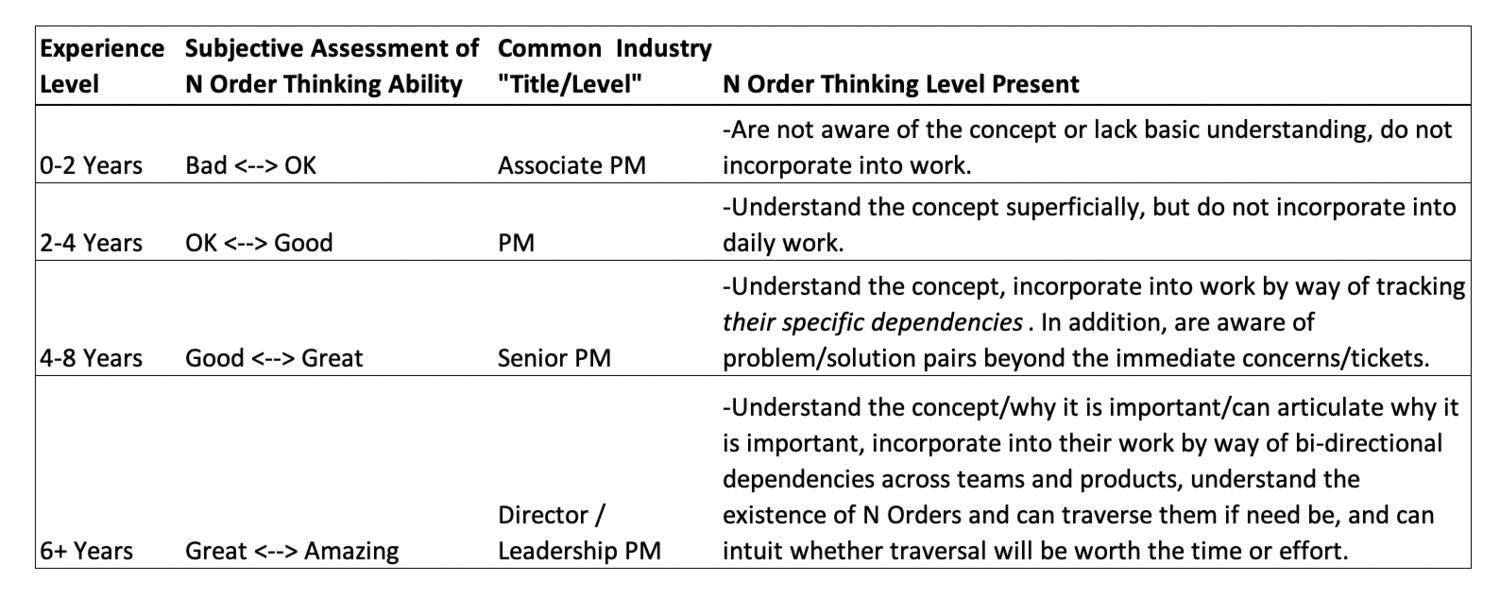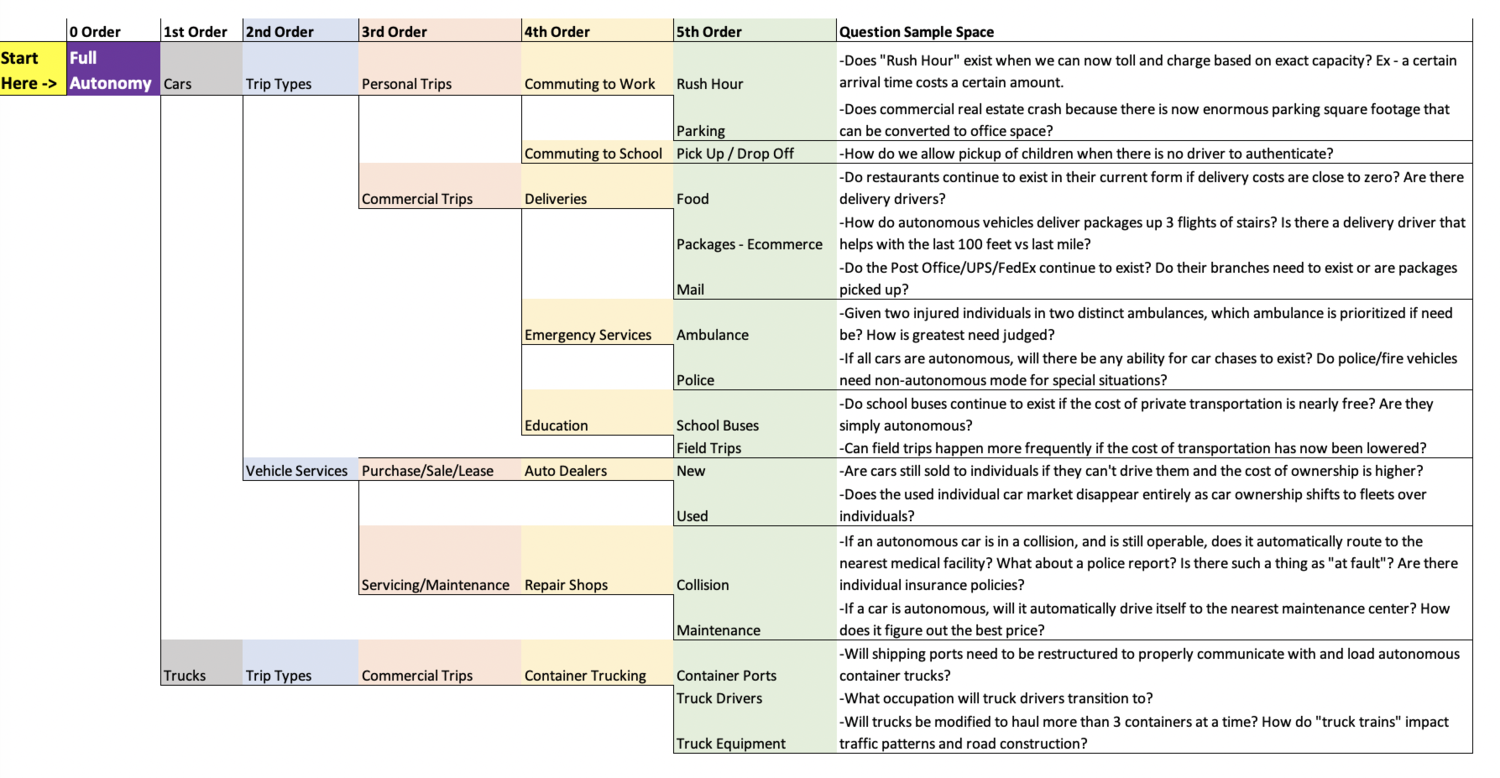N Order Consequence Modeling with Autonomous Vehicles
Summary
- N Order Thinking is simply the ability to think beyond the superficial and consider not just an initial action and potential results, but the actions/potential results N Orders after your initial action/result pair.
- N Order Thinking is important in product management because it allows a deeper understanding of the potential problem/solution space that can be interacted with and that you as a product manager must understand in order to reach a global maximum, not just a local maximum.
- In my experience, N Order Thinking is present to varying degrees based on PM skill levels. N Order Thinking is an incredible differentiator in more junior product managers.
- The below charts for both PM Skill Level and N Order Thinking with Autonomous Vehicles can also be downloaded.

Detailed Discussion
- What is N Order Thinking?
- N Order Thinking is often explained in the context of Second Order or Third Order decision making. While that is useful when introducing the concept, as it is initially difficult to think more than 2 or 3 layers deep, this post is designed to broaden the concept so as to encourage product teams continue beyond the 2 or 3 derivatives this concept typically encapsulates. Hence the term “N” Order Thinking.
- At its simplest, an order of thinking is defined as a layer of observation, question, or statement.
- Example of 1st Order
- Social media advertising is effective and efficient because that is where our demographics spend their time.
- Example of 2nd Order
- Why is social media advertising effective/efficient just because that is where our demographics spend their time? Is that also where/how they plan to purchase our good?
- Social media advertising is effective and efficient because that is where our demographics are most receptive to our advertising and digital creative because we are a digital first brand targeting Gen X in coastal cities.
- The differentiating factor between 1st and 2nd order thinking is going one layer deeper than is typical with three key questions:
- Is the reality that has been presented in the initial statement broadly true (generalizable) or only in specific scenarios (not generalizable)?
- Is the observation properly addressing correlation and causation issues?
- Aside – This is staggeringly overrepresented in product related decisions unfortunately.
- Is the question attempting to identify the root cause of a certain result or simply the one most readily and easily identifiable?
- These three questions can be extended all the way down to N orders of thinking until the product manager feels that they have reached a point at which action can be taken.
- Why is N Order Thinking important and relevant for product teams?
- N Order Thinking is a necessity for continued and sustainable product innovation as it requires the thinker to identify root causes or customer problems that will move the needle, not just those that are easy to solve or will check off a KPI on number of JIRA tickets resolved that week.
- It is also a useful tool in working through complex scenarios in which there are a multitude of stakeholders, potential customers, barriers to entry, and strategies for success. Not unlike a decision tree, N Order Thinking attempts to ferret out the most fundamental attributes of what on first approach seem to be intractably large problem spaces.
- If your team, or at the very least your product leadership team, does not employ N Order Thinking it will be difficult to maintain product leadership in your category over time because you will remain focused on solving problems your customers know they have, not the ones they don’t realize could be solved. Solving problems customers don’t realize they have is the essence of disruption.
- What is the cost of N Order Thinking? When should it be deployed? How can product teams utilize the concept?
- N Order Thinking is useful, but shouldn’t be deployed in every scenario or by every product team member due to the time that it takes to think through each question to the Nth degree.
- It should most often be deployed when entering new markets or creating new products to identify potential problem/solution pairs that may have been overlooked in initial product requirement documents.
- It can also be deployed for products that have stagnated in their market and the product team is attempting to understand whether that product should be deprecated or can be applied to a new use case.
- How can product teams learn to be better N Order Thinkers?
- N Order Thinking is difficult and takes significant effort to understand and incorporate into the way in which your products are built.
- Before going 10 layers deep in a brand new product, attempt the exercise in an existing product or feature that is stagnating and where the problem sample space is relatively narrow.
- It can also be helpful to utilize diagrams, such as the Excel file example of Autonomous Vehicles at the beginning of this post, but which can be as simple as a decision tree drawn on a whiteboard.
Examples
Let’s apply N Order Thinking to what is currently an entirely open ended market: autonomous vehicles. While applying N Order Thinking is typically faster than in this example because your sample space will be constrained by your product, you will also encounter scenarios, similar to the one below, in which you are developing a new product or service with a wide-open set of possibilities. These are necessarily more complicated, and N Order Thinking helps to explore, document, and understand those possibilities.
The following discussion will walk through one branch of the flowchart embedded below, which can also be found in the Excel file linked at the top. This diagram is by no means complete, but is designed to demonstrate how quickly and extensively N Order Thinking can explore new products and business lines.
- On “zero” glance, or zero order, one might state that autonomous vehicles will change the way we drive and transport goods because there will no longer be a human driver.
- This is true, but it doesn’t tell us why it will change the way we drive/transport other than the obvious implication that a human will no longer be driving those vehicles.
- Moving to first order, we might state that there will two types of vehicles that full vehicle autonomy can be applied to: cars and trucks.
- This is also true, but it doesn’t tell us how those autonomous vehicles will interact with their now non-drivers or the service providers that previously supported non-autonomous vehicles.
- This is of course not comprehensive of the vehicle types that autonomous technology could be applied to, but is a good example of how to reduce the scope of an N Order analysis.
- Moving to second order, examining just the car branch, we might now state that autonomous cars will impact the world in two ways: trip types and vehicle service providers.
- Again, true, but have we delineated those trip types or what kind of support vehicle service providers currently provide and how those might be altered with autonomous vehicles?
- Moving to third order, examining just the Trip Types, we might now state there are two trip types, personal and commercial.
- Yet again, a true statement, but we haven’t yet answered one of the three questions above, which is whether we have identified the root cause / problem / potential business.
- Moving to fourth order, examining just the Commercial Trips, we can identify that there are potentially three stakeholder groups impacted: Deliveries, Emergency Services, and Education.
- We are getting closer as we are starting to identify individual business segments, but we aren’t yet at a level of specificity where we can identify problems to solve because we haven’t identified potential stakeholders.
- Moving to fifth order, examining just the Deliveries branch, we can identify a specific enough industry that we can start asking intelligent questions.
- In this case, if we look at delivering Mail, we can start to ask whether those types of Car -> Trip Type -> Commercial Trips -> Deliveries -> Mail will make sense if the underlying vehicle will be autonomous.
- Getting to this level allows us to see the entire picture in which those decisions will be made (the other segments such as Food and Packages – E-Commerce) and whether those segments might be more appealing because they have higher/lower barriers to entry, lower / higher CLTVs, more / fewer competitors, etc.
- In other words, your product team is unlikely to do well building a product that caters to solving the problems of a 4th order segment and all of its corresponding branches (IE – Deliveries -> Food & Packages – E-Commerce & Mail) because the use cases will be so different.
- N Order thinking allows a bottom up approach to identifying potential business segments and their potential problems that can be turned into business / product lines.
